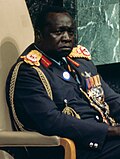 |
|---|
This is a list of the heads of state of Uganda, from the independence of Uganda in 1962 to the present day.
Contents
- Commonwealth realm (1962–1963)
- Governor-general
- Elective monarchy (1963–1966)
- Republic (1966–present)
- First Republic (1966–1971)
- Second Republic (1971–1979)
- Third Republic (1979–1985)
- Military rule (1985–1986)
- Fourth Republic (1986–present)
- Timeline since 1963
- Notes
- References
- External links
From 1962 to 1963, the head of state under the Constitution of 1962 was the queen of Uganda, Elizabeth II, who was also the monarch of other Commonwealth realms. The queen was represented in Uganda by a governor-general. Uganda removed Elizabeth II as head of state under a 1963 constitutional amendment and the monarch and governor-general were replaced by a ceremonial president. The president under the 1963 constitution was an elective monarch, chosen by the parliament from among Uganda's five traditional kings. Uganda became a republic within the Commonwealth when this system was replaced by an executive presidency in 1966.








